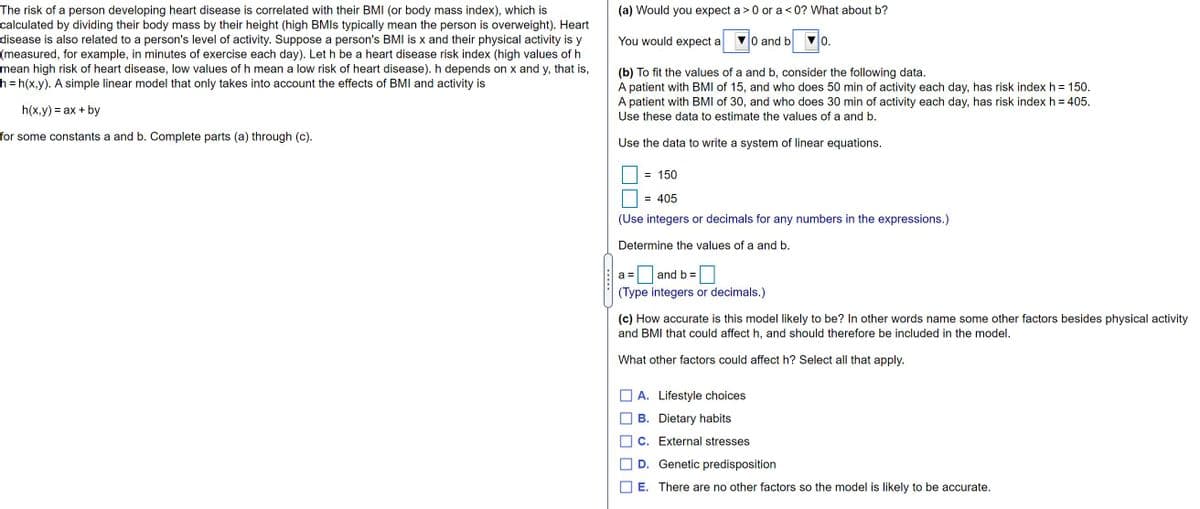(a) Would you expect a>0 or a<0? What about b? You would expect a 0 and b o. (b) To fit the values of a and b, consider the following data. A patient with BMI of 15, and who does 50 min of activity each day, has risk index h = 150. A patient with BMI of 30, and who does 30 min of activity each day, has risk index h = 405. Use these data to estimate the values of a and b. Use the data to write a system of linear equations. = 150 = 405 (Use integers or decimals for any numbers in the expressions.) Determine the values of a and b. a=D and b=D (Type integers or decimals.) (c) How accurate is this model likely to be? In other words name some other factors besides physical activity and BMI that could affect h, and should therefore be included in the model. What other factors could affect h? Select all that apply. A. Lifestyle choices B. Dietary habits ]C. External stresses
(a) Would you expect a>0 or a<0? What about b? You would expect a 0 and b o. (b) To fit the values of a and b, consider the following data. A patient with BMI of 15, and who does 50 min of activity each day, has risk index h = 150. A patient with BMI of 30, and who does 30 min of activity each day, has risk index h = 405. Use these data to estimate the values of a and b. Use the data to write a system of linear equations. = 150 = 405 (Use integers or decimals for any numbers in the expressions.) Determine the values of a and b. a=D and b=D (Type integers or decimals.) (c) How accurate is this model likely to be? In other words name some other factors besides physical activity and BMI that could affect h, and should therefore be included in the model. What other factors could affect h? Select all that apply. A. Lifestyle choices B. Dietary habits ]C. External stresses
Algebra & Trigonometry with Analytic Geometry
13th Edition
ISBN:9781133382119
Author:Swokowski
Publisher:Swokowski
Chapter7: Analytic Trigonometry
Section7.6: The Inverse Trigonometric Functions
Problem 94E
Related questions
Question

Transcribed Image Text:The risk of a person developing heart disease is correlated with their BMI (or body mass index), which is
calculated by dividing their body mass by their height (high BMIS typically mean the person is overweight). Heart
disease is also related to a person's level of activity. Suppose a person's BMI is x and their physical activity is y
(measured, for example, in minutes of exercise each day). Let h be a heart disease risk index (high values of h
mean high risk of heart disease, low values of h mean a low risk of heart disease). h depends on x and y, that is,
h3h(x,y). A simple linear model that only takes into account the effects of BMI and activity is
(a) Would you expect a > 0 or a < 0? What about b?
You would expect a 7o and b
0.
(b) To fit the values of a and b, consider the following data.
A patient with BMI of 15, and who does 50 min of activity each day, has risk index h = 150.
A patient with BMI of 30, and who does 30 min of activity each day, has risk index h = 405.
Use these data to estimate the values of a and b.
h(x,у) 3D ах + by
for some constants a and b. Complete parts (a) through (c).
Use the data to write a system of linear equations.
= 150
= 405
(Use integers or decimals for any numbers in the expressions.)
Determine the values of a and b.
a =
and b =
(Type integers or decimals.)
(c) How accurate is this model likely to be? In other words name some other factors besides physical activity
and BMI that could affect h, and should therefore be included in the model.
What other factors could affect h? Select all that apply.
A. Lifestyle choices
B. Dietary habits
C. External stresses
D. Genetic predisposition
E. There are no other factors so the model is likely to be accurate.
Expert Solution
This question has been solved!
Explore an expertly crafted, step-by-step solution for a thorough understanding of key concepts.
Step by step
Solved in 3 steps

Recommended textbooks for you

Algebra & Trigonometry with Analytic Geometry
Algebra
ISBN:
9781133382119
Author:
Swokowski
Publisher:
Cengage



Algebra & Trigonometry with Analytic Geometry
Algebra
ISBN:
9781133382119
Author:
Swokowski
Publisher:
Cengage



Trigonometry (MindTap Course List)
Trigonometry
ISBN:
9781337278461
Author:
Ron Larson
Publisher:
Cengage Learning

Glencoe Algebra 1, Student Edition, 9780079039897…
Algebra
ISBN:
9780079039897
Author:
Carter
Publisher:
McGraw Hill

College Algebra
Algebra
ISBN:
9781305115545
Author:
James Stewart, Lothar Redlin, Saleem Watson
Publisher:
Cengage Learning